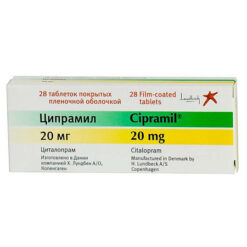No products in the cart.
Cipramil 20 mg, 14 pcs.
€1.00
Out of stock
(E-mail when Stock is available)
Description
CYPRAMIL is an antidepressant, selective serotonin reuptake inhibitor (SSRI).
Pharmacodynamics.
CYPRAMIL has no or very weak ability to bind to a number of receptors, including histamine, muscarinic and adrenoreceptors. This largely explains why CYPRAMIL has no cardiotoxicity and no side effects in the form of orthostatic hypotension, sedation or dry mouth.
CYPRAMIL only inhibits cytochrome P450IID6 to a very small extent, and therefore does not interact with drugs metabolized by this enzyme.
The antidepressant effect usually develops after 2-4 weeks of treatment. CYPRAMIL has no effect on cardiac conduction and blood pressure, hematological parameters, hepatic and renal function and does not cause increase in body weight.
Pharmacokinetics.
The bioavailability of citalopram when taken orally is about 80%. Maximum plasma concentration is reached 2-4 hours after ingestion. Protein binding is below 80%.
Metabolism is by demethylation, deamination and oxidation. Unchanged citalopram is the major compound in plasma; its kinetics are linear.
The steady plasma concentration is established after 1-2 weeks of treatment. The half-life of the drug is 1.5 days. Excretion is with urine and feces.
Indications
Indications
Active ingredient
Active ingredient
Composition
Composition
Active substance:
citalopram hydrobromide 20 mg;
Ancillary substances:
Corn starch,
Lactose monohydrate,
copovidone,
glycerin 85%,
microcrystalline cellulose,
croscarmellose sodium,
magnesium stearate.
Shell:
Hypromellose 5, macrogol 400, titanium dioxide (E 171).
How to take, the dosage
How to take, the dosage
CYPRAMIL is prescribed once a day. The drug can be used at any time of the day regardless of meals.
Depression: Therapy of depression is started with 20 mg of CYPRAMIL per day. Depending on the individual response of the patient and the severity of depression, the dose can be increased to a maximum of 60 mg per day.
Panic disorder: during the first week of treatment, a dose of 10 mg of CYPRAMIL per day is recommended, then the dose is increased to 20 mg per day. The daily dose, depending on the individual reaction of the patient, may be increased later. The maximum dose is 60 mg/day.
Obsessive-compulsive disorder: The initial dose of CYPRAMIL is 20 mg daily. If necessary, the dose may be increased. The maximum dose is 60 mg per day.
Elderly patients (over 65 years of age). The recommended daily dose for the elderly is 20 mg. Depending on individual response and severity of depression, the dose may be increased to a maximum of 40 mg per day.
In case of hepatic impairment, administration of the drug should be limited to the minimum recommended doses. The maximum dose is 30 mg daily.
In mild to moderately severe renal insufficiency, no dose adjustment is required.
Interaction
Interaction
No chemically incompatible combinations have been identified.
The concomitant use of CYPRAMIL and MAO inhibitors may cause a hypertensive crisis (serotonin syndrome).
CYPRAMIL may increase the effects of sumatriptan and other serotonergic drugs.
Concomitant use of cimetidine causes a moderate increase in the equilibrium blood concentration of CYPRAMIL. Therefore, caution is recommended when maximum doses of CYPRAMIL are administered concomitantly with high doses of cimetidine.
No interactions of CYPRAMIL with lithium and alcohol have been identified. However, concomitant use of CYPRAMIL and alcohol is not recommended.
No clinically significant pharmacokinetic interaction with phenothiazines and tricyclic antidepressants was found.
In clinical trials no pharmacodynamic interaction of CYPRAMIL with benzodiazepines, neuroleptics, analgesics, lithium, antihistamines, antihypertensives, beta-adrenoblockers and other cardioactive drugs was revealed.
Special Instructions
Special Instructions
The risk of suicide is intrinsic to depression and may persist until a significant improvement has occurred spontaneously or as a result of ongoing therapy. Close monitoring of patients treated with antidepressants is necessary, especially at the beginning of treatment, because of the possibility of clinical deterioration and/or the appearance of suicidal manifestations (thoughts and behavior). This precaution should also be observed when treating other psychiatric disorders because of the possibility of a concurrent depressive episode.
The use of SSRIs in the third trimester of pregnancy may adversely affect the psychophysical development of the newborn. The following disorders have been recorded in newborns whose mothers took SSRIs until delivery: irritability, tremor, hypertension, increased muscle tone, constant crying, difficulty sucking, and poor sleep. Disorders may indicate serotoninergic effects or the onset of withdrawal syndrome. If SSRIs are used during pregnancy, they should not be abruptly interrupted.
CYPRAMIL should be used with caution in persons whose activities involve operating machinery or driving moving vehicles. CYPRAMIL does not impair intellectual ability or speed of psychomotor reactions. However, patients treated with CYPRAMYL may be expected to have some impairment of attention and concentration due to the disease, the treatment or both.
Contraindications
Contraindications
The drug should not be used in combination with monoamine oxidase inhibitors (MAOIs), including selegiline, and within 14 days after stopping their administration. Treatment with MAO inhibitors may be started not earlier than 7 days after discontinuation of CYPRAMIL.
CYPRAMIL should not be administered to pregnant and lactating women if the potential clinical benefit does not prevail over the theoretical risk, because the safety of the drug in pregnancy and lactation in humans has not been established.
Side effects
Side effects
The undesirable effects of CYPRAMIL are transient and mild. They occur during the first one to two weeks of treatment and usually subside significantly as patients improve.
There may be dry mouth, nausea, drowsiness, weakness, increased sweating, tremors, agitation, insomnia, diarrhea, and sexual dysfunction.
CYPRAMIL may cause a slight decrease in heart rate, which is usually of no clinical significance. However, in patients with an initially low heart rate it may lead to bradycardia. In exceptional cases, when using high doses of the drug, seizures may develop.
Hyponatremia, serotonin syndrome, withdrawal syndrome, extrapyramidal disorders, and purpura are extremely rare.
In case of phase inversion and development of a manic state, CYPRAMIL should be discontinued.
Overdose
Overdose
Symptoms. The following symptoms and signs may occur: somnolence, coma, articulation disorders, episodes of grand mal seizures (grand mal), sinus tachycardia, sometimes nodal rhythm, increased sweating, nausea, vomiting, cyanosis, hyperventilation. The clinical picture is not characteristic.
Treatment. There is no specific antidote. Treatment is symptomatic and supportive. Gastric lavage should be performed as soon as possible after oral administration of CYPRAMIL. Medical observation is recommended.
Pregnancy use
Pregnancy use
The safety of citalopram administration during pregnancy and lactation has not been established. Use is justified only in cases when the potential benefit of therapy for the mother exceeds the possible risk to the fetus and child.
The experimental studies did not reveal teratogenic effect and any influence of citalopram on reproductive function and perinatal development of the fetus.
Similarities
Similarities
Additional information
| Shelf life | 5 years. |
|---|---|
| Conditions of storage | Store at a temperature not exceeding 30 ° C. |
| Manufacturer | Х. Lundbeck A/O, Denmark |
| Medication form | pills |
| Brand | Х. Lundbeck A/O |
Other forms…
Related products
Buy Cipramil 20 mg, 14 pcs. with delivery to USA, UK, Europe and over 120 other countries.
















